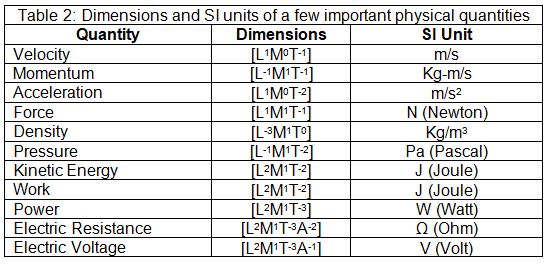Measurement is the assignment of a number to a characteristic of an object or event which can be compared with other objects or events. [Wikipedia] Measurement of any physical quantity is indicated by a number followed by a unit. Units are the standard reference in terms of which measurements are expressed.
There are a host of physical quantities present in our world like length, mass, force, temperature, power, momentum, etc. These can be sub-divided into two groups: fundamental or base quantities and derived quantities. The quantities that cannot be expressed in terms of any other quantities are called fundamental quantities, for example, length, mass, etc. Whereas derived quantities can be derived from fundamental quantities. Force, for example, can be expressed in terms of mass, length, and time, hence force is a derived quantity.
|
Table 1: Various International System of Units |
|
|
Name |
Full-Form |
|
CGS |
Centimeter, Gram, Second |
|
FPS |
Foot, Pound, Second |
|
MKS |
Meter, Kilogram, Second |
|
SI Units |
Systeme Internationale d’ Units |
Out of all the systems of units shown in table 1, at present SI units are accepted worldwide. Table 2 shows the seven fundamental units present in the SI system. Along with these seven fundamental units, two more units are defined: radian (r) for the plane angle and steradian (sr) for the solid angle.
|
Table 2: Fundamental Units in SI System |
||
|
Physical Quantity |
Unit |
Symbol |
|
Length |
Meter |
m |
|
Mass |
Kilogram |
kg |
|
Time |
Second |
s |
|
Temperature |
Kelvin |
A |
|
Electric Current |
Ampere |
K |
|
Amount of Substance |
Mole |
mol |
|
Luminous Intensity |
Candela |
Cd |
Errors
The difference between the actual value and calculated or experimental value of a physical quantity is known as error. Errors can be categorized into two parts: 1) systematic errors, and 2) random errors.
Systematic errors originated from instrumental errors (imperfect instrument design, zero error, etc.), wrong experimental techniques, and/or personal bias. These errors tend to be unidirectional (either positive or negative) and can be minimized by selecting better functioning instruments, cutting down personal biases, and correcting experimental techniques. Systematic errors may be estimated and suitable corrections can be applied for a particular experimental set-up.
Random errors are irregular and random with respect to sign and size. They arise due to unpredictable fluctuations and observational errors. Least count error is a kind of random error that can be improved by higher precision instruments.
Absolute error, relative error, and percentage error:
- The absolute difference between the actual value and the calculated or measured value is known as the absolute error. The arithmetic mean of all the absolute errors is known as mean absolute error.
- The ratio of mean absolute error to the mean calculated or measured value is known as the relative error.
- Percentage error is nothing but the relative error expressed in percent, i.e. relative error x 100%.
- The absolute error in the final quantity is the sum of the absolute errors in the individual quantities when we add or subtract two quantities.
- The relative error in the final quantity is the sum of relative errors in individual quantities when we multiply or divide two quantities.






0 Comments